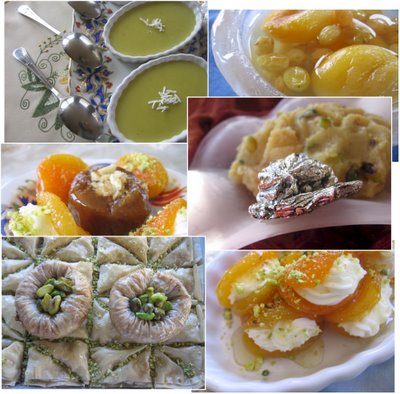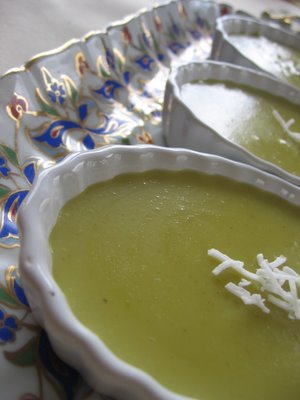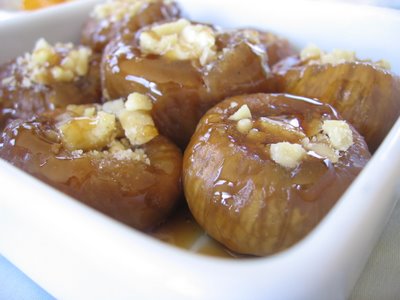What Did the Sultans Have for Dessert?
 The theme for last month's Turkish blog event was Delicacies from the Ottoman Palace. This gave me a good chance to research on Ottoman desserts as well as to try a few new things. I was pleased to see that almost all the desserts I encountered in my research still continue to grace our tables today in one form or the other. The difference, it seems, is in the manner of preparation and service. In the spirit of the historical theme, I refrained as much as I could from taking any shortcuts, and made an effort to do things as I imagined they would be done in the palatial kitchens more than a hundred years ago. I did not plan to make as many dishes initially, but I guess I got carried away somewhere along the way, and after 2 days of complete immersion in the subject, I emerged from my kitchen with 6 different desserts and a profound appreciation for Ottoman cuisine. It was definitely a worthwhile experience!
The theme for last month's Turkish blog event was Delicacies from the Ottoman Palace. This gave me a good chance to research on Ottoman desserts as well as to try a few new things. I was pleased to see that almost all the desserts I encountered in my research still continue to grace our tables today in one form or the other. The difference, it seems, is in the manner of preparation and service. In the spirit of the historical theme, I refrained as much as I could from taking any shortcuts, and made an effort to do things as I imagined they would be done in the palatial kitchens more than a hundred years ago. I did not plan to make as many dishes initially, but I guess I got carried away somewhere along the way, and after 2 days of complete immersion in the subject, I emerged from my kitchen with 6 different desserts and a profound appreciation for Ottoman cuisine. It was definitely a worthwhile experience!For all the desserts I made for this blog event, I used Ayla Esen Algar's wonderful book Classical Turkish Cooking. I will post the recipes upon request.
Pistachio Pudding
 We eat a more popular almond version of this pudding --called keskul-- almost every time we go to a Turkish restaurant. In Turkey, there are dessert shops called muhallebici specializing in dairy desserts, so people rarely make keskul at home. I attempted to make it only once before; the taste was acceptable but I was not happy with the texture. This time, I followed a different recipe and used pistachios instead of the more traditional almonds. The result was a smooth and delicious pudding delicately flavored by pistachios.
We eat a more popular almond version of this pudding --called keskul-- almost every time we go to a Turkish restaurant. In Turkey, there are dessert shops called muhallebici specializing in dairy desserts, so people rarely make keskul at home. I attempted to make it only once before; the taste was acceptable but I was not happy with the texture. This time, I followed a different recipe and used pistachios instead of the more traditional almonds. The result was a smooth and delicious pudding delicately flavored by pistachios.- 1/3 cup uncooked rice soaked in 2/3 c water overnight
- 1 rounded c of unsalted pistachios
- 2/3 c sugar
- 3 c hot milk plus 1 c milk
- 1 c heavy cream

Turks love to eat dried fruit and nuts together. When I was a child, we used to snack on dried apricots stuffed with almonds, dried figs stuffed with walnuts, or chick peas and raisins. The following two desserts are more sophisticated implementations of the same idea.
Fig Dessert

Dried Apricots with Clotted Cream

- 6 oz dried apricots
- 1/4 c sugar
- 3 1/2 c water
- 1 tsp lemon juice
- 1/2 c kaymak, whipped cream or mascarpone
- Ground unsalted pistachios for decoration
Combine sugar and water in a pot and bring to a boil. Add the apricots and simmer until they are soft (20-25 minutes). Remove them from the syrup and leave to cool. Meanwhile, your syrup must already have thickened, boil it for another couple of minutes, add the lemon juice and leave to cool.
Open the cooked apricots along the ridges taking care not to separate the halves. Fill them with your choice of filling. Cover and chill until serving time. Serve them drizzled with the apricot syrup and a generous sprinkle of ground pistachios.
Saffron and Pistachio Helva
 In the 15th century, the Ottoman palatial kitchens were rebuilt to include a structure with six domes called the Helvahane, or "House of Helva", where numerous varieties of helva as well as jams, sherbets and herbal remedies were made. By mid eighteenth century, the six different kinds of helva prepared in the Helvahane were all assigned to different chefs with a hundred apprentices working under each of them... Today, preparation of helva still marks religious days and happy occasions such as births as well as solemn ones as deaths.
In the 15th century, the Ottoman palatial kitchens were rebuilt to include a structure with six domes called the Helvahane, or "House of Helva", where numerous varieties of helva as well as jams, sherbets and herbal remedies were made. By mid eighteenth century, the six different kinds of helva prepared in the Helvahane were all assigned to different chefs with a hundred apprentices working under each of them... Today, preparation of helva still marks religious days and happy occasions such as births as well as solemn ones as deaths.- 1/2 tsp saffron threads
- 2 tbs hot milk
- 1/3 c shelled unsalted pistachios
- 4 oz unsalted butter
- 1 c sugar
- 2 c milk
- 1 c semolina
Dried Fruit Compote in an Ice Bowl
 Ottomans paired elaborate rice dishes with cool fruit compotes called Hosaf. Technically speaking, hosafs were side dishes rather than dessert. They were made with fresh or dried fruits, and perfumed with flower essences, musk and ambergris. I read somewhere that in the Ottoman palace, hosafs were served in bowls fashioned from their own frozen juice. This way, it was possible to keep them cool without diluting the taste. After several unsuccesful attempts at it, I started to seriously doubt the authenticity of what I read. But I did not give up and made an ice bowl instead which worked beautifully to cool the hosaf. (My husband also made an ice bowl; the picture above shows his bowl and the one you see below is mine.)
Ottomans paired elaborate rice dishes with cool fruit compotes called Hosaf. Technically speaking, hosafs were side dishes rather than dessert. They were made with fresh or dried fruits, and perfumed with flower essences, musk and ambergris. I read somewhere that in the Ottoman palace, hosafs were served in bowls fashioned from their own frozen juice. This way, it was possible to keep them cool without diluting the taste. After several unsuccesful attempts at it, I started to seriously doubt the authenticity of what I read. But I did not give up and made an ice bowl instead which worked beautifully to cool the hosaf. (My husband also made an ice bowl; the picture above shows his bowl and the one you see below is mine.)
Nightingale's Nest and Baklava
 Of course, when the theme is palace delicacies, we simply can not conclude without paying a tribute to pastry-based desserts. In those pre-Phyllo times, baklava dough was hand made and a tray of baklava typically consisted of 50-60 layers of paper-thin handmade sheets of pastry. Baklava and its varities are still very popular in Turkey with many specialized shops in every city. For this blog event, I tried to make Bulbul Yuvasi (Nightingale's Nest) using Phyllo dough.
Of course, when the theme is palace delicacies, we simply can not conclude without paying a tribute to pastry-based desserts. In those pre-Phyllo times, baklava dough was hand made and a tray of baklava typically consisted of 50-60 layers of paper-thin handmade sheets of pastry. Baklava and its varities are still very popular in Turkey with many specialized shops in every city. For this blog event, I tried to make Bulbul Yuvasi (Nightingale's Nest) using Phyllo dough.


















<< Home